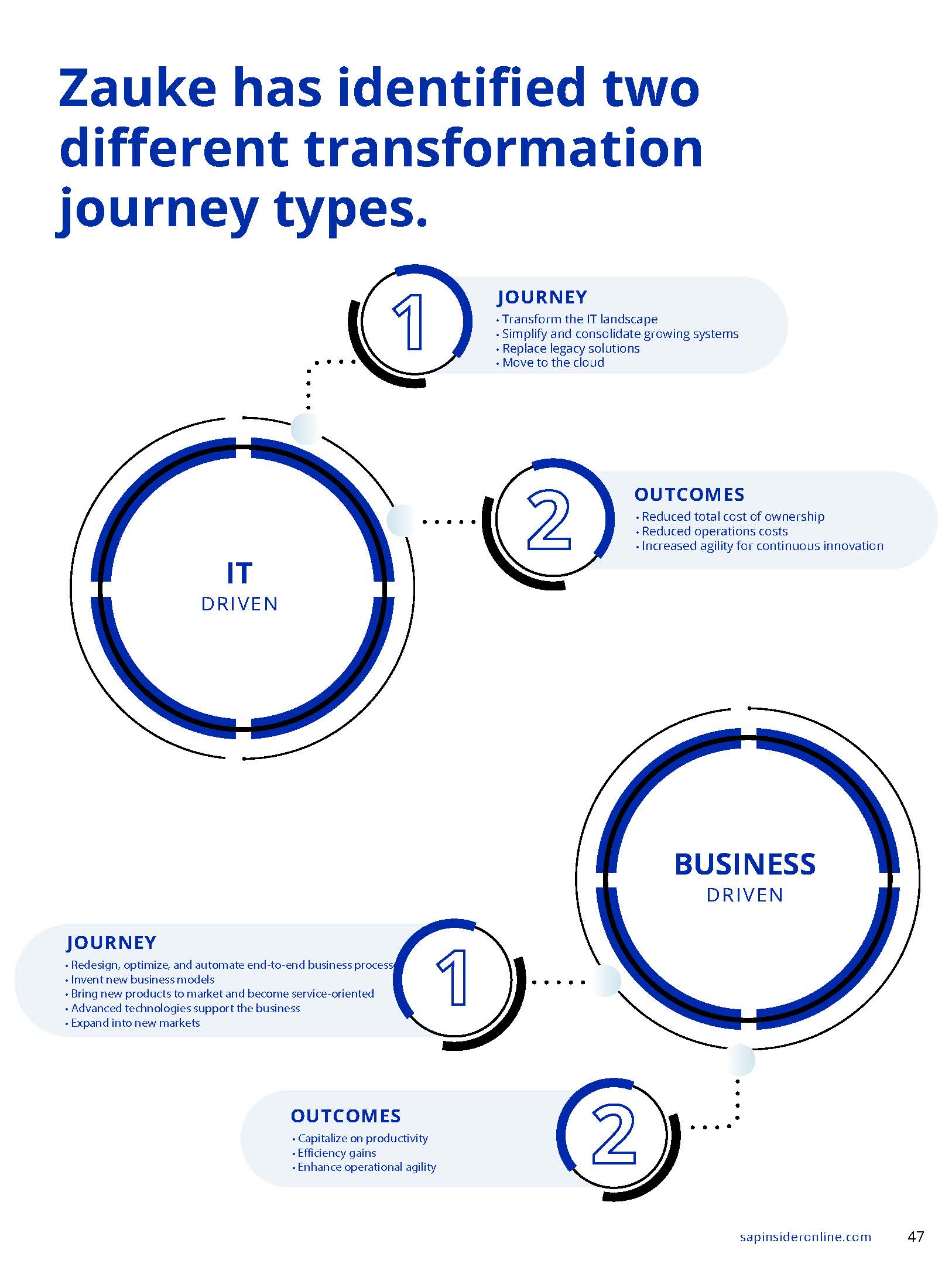SAP Customers Expand Global Footprints
A popular approach to transformation is driving technology adoption
By Brianna Shipley, Director of Editorial, SAPinsider
Editor’s note: This article appears in SAPinsider’s 2021 September Executive Magazine.
Eva Zauke’s passion is simple: Deliver customer value. This seemingly uncomplicated ambition — which is shared by her business unit at SAP, where Zauke serves as the Global Head of SAP Enterprise Adoption — is anything but.
“We are helping customers to adopt SAP solutions and to create value from their investments,” says Zauke.
What’s so complicated about that? Value, it seems, is a loaded term.
We broke down SAP’s recommendation in November 2020 that customers become an intelligent enterprise and how the prescriptive journey evolved to meet companies where they were: building resilience after the pandemic. SAP called it getting “back to best” and said that SAP’s vision is to help the world run as a network of intelligent, sustainable enterprises. Intelligent enterprises succeed, and they enable millions of people to work how they want, where they want.
SAP says that to make the transformation to the intelligent enterprise a success, business outcomes and value realization need to be at the center of a company’s digital journey. As a result, such a company is more likely to experience value in terms of resiliency, performance, and sustainability.
Each of these value terms alone is packed with meaning. To add to the complexity, Zauke is seeing companies expand and become truly global at an increasing rate.
As a result, “the intelligent enterprise needs to do more than just span processes and technologies — it needs to span companies’ global and local footprints, their presence in their respective countries, global supply chains, as well as span the entire workforce,” Zauke says.

Eva Zauke, Global Head of SAP Enterprise Adoption, SAP
She adds that in the end, becoming an intelligent enterprise boils down to the customer business being able to operate globally and locally and the employees who are making the digital transformation a success. Organizational adoption of SAP solutions is a key lever to achieve desired business outcomes.
“Our business is here to provide essential capabilities to make both the global and local presence of SAP customers a success, and also provide abilities to make the workforce successful in adopting new business processes and technologies while transforming to the intelligent enterprise,” Zauke says.
And technology adoption is accelerating, says Zauke, including adoption of both global and localized solutions. She explains that SAP Enterprise Adoption can be viewed as a natural progression in the SAP portfolio to support customers along their transformation journeys. The value benefits of business and technology adoption the way Zauke sees them are similar to those that can be achieved by the intelligent enterprise — enabling customers to make impactful changes to run their business and in turn become more resilient, perform better, and be more sustainable — in essence, a best-run business.
- Resiliency. With ongoing global requirements and constantly evolving local legislations and regulations, Zauke defines this as the ability to adapt quickly, like redirecting your supply chain to a new business route or pivoting to a new business model.
- Performance. This can be measured in two facets: The efficiency of digital processes (i.e., tax reporting, invoicing, exchange of documents) and employee performance. According to one global market research company, when users are well enabled, companies see 15% improvement in user satisfaction and 51% improvement in their key business performance measures.
- Sustainability. According to Zauke, SAP among many other activities, contributes to sustainability in the areas of reduction and optimizing the carbon footprint by reporting on respective regulations. This is a common lens with which customers look at and think about sustainability, she says, but it’s also important to consider a different perspective: one focused on the employee and the user. “To help make digital transformation a success, companies should embrace the global and local nature in which customers operate and enable their users and employees in the language of choice. This combination contributes to managing the resource of the employee and evolving the digital transformation in a sustainable way.”
In addition to shared value benefits, Zauke has witnessed a few commonalities across organizations seeking to expand: a need to consider varying reporting, compliance, and tax requirements, language barriers and localized software, and an increased importance around conversations about skill development.
“Skills gap remains a major barrier to digital transformation. According to a McKinsey study, a transformation is three times more likely to be successful when companies have invested the right amount into the talent,” Zauke says.
Zauke adds that many of the challenges customers face today are still related to disruption caused by the pandemic, but her team is here to help them prepare for a new normal.
“I am really passionate about the work we do to help our customers. I’m passionate about the difference we are making. This sense of pride is what drives my team and me.”

Zauke has identified two types of journeys that enterprises take when they are transforming.
Accelerators of Adoption
Zauke has identified the following drivers of adoption and says that these drivers — both regulatory and market in nature — appear to be similar across the regions.
- Handling large volumes of data. Technology innovations like Internet of Things (IoT), big data, analytics, and machine learning are being adopted to meet this need, Zauke says.
- Innovations around cloud solutions and intelligence analytics. These are opening up new opportunities and driving cloud adoption.
- Government regulations. The digitalization of governments and the interaction of governments with businesses is moving forward considerably, Zauke says.
- Upskilling the workforce. Given the advancement in technologies including AI and machine translation, the right investment in talent and skill development adds value to the business and helps accelerate adoption.
- Pandemic. Any kind of disruption fuels innovation because businesses have to react quickly and get creative in the way they serve their customers, Zauke says.
What Does This Mean for SAPinsider Executives?
- Build upskilling and enablement into your company culture. Zauke says that companies are investing in skills with regards to cloud, security, and IoT, as well as analytical skills like data science. There’s a third dimension, she says, around developing competencies with regard to agile and soft skills like communication and presentation abilities. “Companies are investing in the enablement of their workforce with regards to soft skills. They know it’s not just about the technology and the business processes but also about how people interact with the technology and with each other from a resiliency standpoint.” Employees that are enabled on day one of their job are more satisfied and more productive.
- Consider awareness a strategic advantage. Zauke recommends staying up to date on not only market trends, but also on how the company is evolving its technology and business processes. As part of an ongoing series, SAPinsider will be partnering with Zauke and her team to bring you customer stories that share which technologies leading companies are adopting, how they are re-imagining business models, and strategies they are implementing to achieve business results.
- Understand how each course contributes to the whole meal. Adopt a holistic view of the company, says Zauke, and then bring this to life in smaller pieces through programs and pilot projects. Demonstrate improvements and benefits in a way that users can understand the impact on their day-to-day role — not just from a business perspective.
- Put SAP S/4HANA at the core. Consider whether your journey is more IT- or business-driven, and in either scenario, SAP S/4HANA will span across the journey. “It can enable a business to consolidate and simplify its landscape into one database, reducing TCO, and also address business processes with capabilities and technologies like machine learning and embedded analytics,” Zauke says. In her experience many SAP customers typically start with the technical migration — taking advantage of the benefits of simplifying and consolidating their landscape — and then moving forward with expanding into multiple countries with real-time essential software solutions delivered in localized versions and with local language transforming their business processes and taking advantage of the intelligence that’s built in with SAP S/4HANA.
- Run successfully in individual countries as well as globally. Consider localization per country where a company is operating. Localization can apply to processes related to expense, recruitment, payroll, human resources management, expense management, and finance, including payments or taxes, electronic invoicing, statutory reporting and sustainability. “Here SAP empowers its customers to operate successfully in individual countries as well as globally. For guidelines, laws and legal mandates in countries, SAP has the advantage to draw on its vast experience in localization for many years. Operating on a global level this also means running compliant to new digital compliance regulations with document (e-invoice, e-order) and reporting compliance,” Zauke says.








